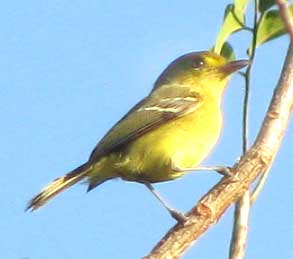Excerpts from Jim Conrad's
Naturalist Newsletter
from the February 14, 2010 Newsletter issued from Hacienda Chichen Resort beside Chichén Itzá Ruins, central Yucatán, MÉXICO; limestone bedrock, elevation ~39m (~128ft), ~N20.676°, ~W88.569°
MANGROVE VIREO

At this time of year you see a lot of small, grayish vireos with yellowish underparts working through dense second-growth, at forest edges and in brushy fields. In the mornings they draw attention to themselves with their persistent, buzzy scolding, chi-chi-chi... They're Mangrove Vireos, VIREO PALLENS. One is shown above
When you see them you know they're not warblers because their beaks are so heavy and they move more sluggishly than warblers. During the winter many White-eyed Vireos also are here, in similar habitats, but they display white throats and irises. Yellow- throated Vireos are less common, and show white bottoms instead of the Mangroves' yellow ones. Maybe the best field mark for the Mangrove is that the space between the eyes and the beak (the lores) is especially broad and yellowish.
It's interesting that the species is divided into two widely separated populations. The population along the Pacific Coast ranges from Mexico to Costa Rica, and never is found far from mangroves. However, the Yucatan population occurs even farther inland than we are, and we're over 50 miles (80 kms) from any mangroves. Also, in the Yucatan yellowish-olive and grayish-olive morphs occur. It looks like the one in the picture is the yellowish-olive one.